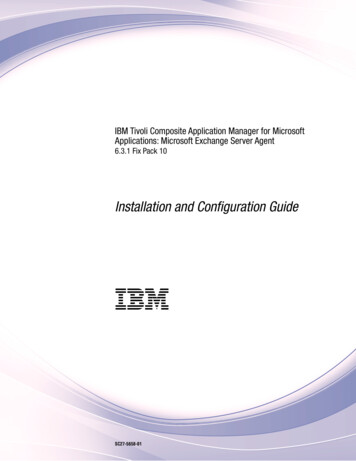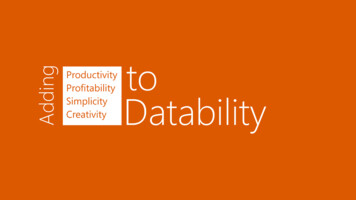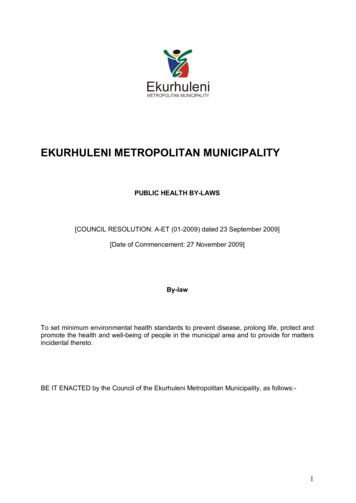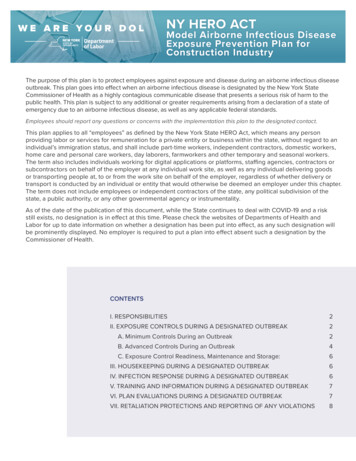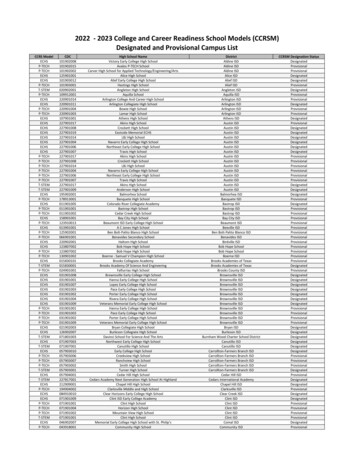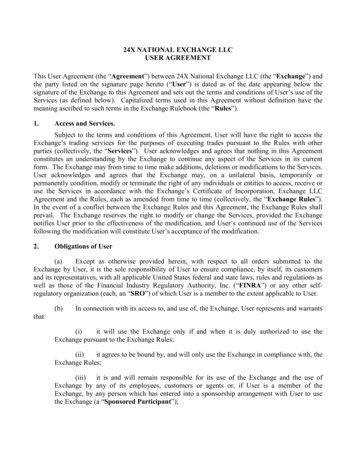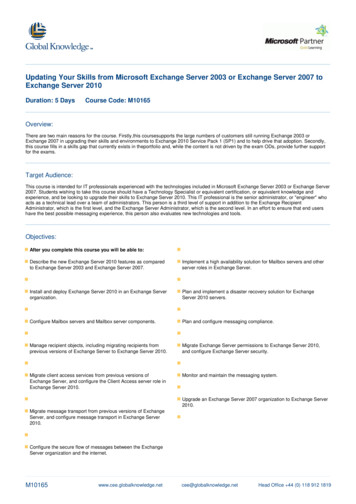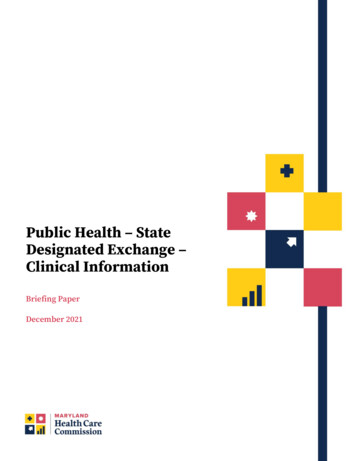
Transcription
Public Health – StateDesignated Exchange –Clinical InformationBriefing PaperDecember 2021
Andrew N. Pollak, MD, ChairmanProfessor and Chair, Department of OrthopaedicsUniversity of Maryland School of MedicineChief of Orthopaedics, University of Maryland Medical SystemBimbola Akintade, PhDUniversity of Maryland School of NursingAssociate Professor for the School of NursingMark T. Jensen. EsqPartnerBowie & Jensen, LLCArun Bhandari, MDChesapeake Oncology HematologyAssociates, PAJeffrey Metz, MBA, LNHAPresident and AdministratorEgle Nursing and Rehab CenterCassandra Boyer, BABusiness Operations ManagerEnterprise Information Systems DirectorateUS Army Communications Electronics CommandGerard S. O’Connor, MDGeneral Surgeon in Private PracticeMarcia Boyle, MSFounderImmune Deficiency FoundationMichael J. O’Grady, PhDPrincipal, Health Policy LLC, and Senior Fellow,National Opinion Research Ctr(NORC) at the University of ChicagoTrupti N. Brahmbhatt, PhDSenior Policy ResearcherRand CorporationMartha G. Rymer, CPARymer & Associates, PATinisha Cheatham, MDPhysician in Chief of the Mid-AtlanticPermanente Medical GroupRandolph S. Sergent, EsqVice Chair, Maryland Health Care CommissionVice President and Deputy General CounselCareFirst BlueCross BlueShieldMartin L. “Chip” Doordan, MHARetired Chief Executive OfficeAnne Arundel Medical CenterMarcus L. Wang, EsqCo-Founder, President and General ManagerZytoGen Global Genetics Institute
Table of ContentsSummary .4Discussion .5Data Supports Health Care Reform – Key Federal Drivers .6Nursing Home EHR HIE Integration – A Pressing Need.7EHN Administrative Transactions – Support for Population Health Programs .8HIE EHN Administrative Transaction Integration .9About CRISP .9Legislative Update – Funding and Sustainability .10Appendix A – The Law . 12Appendix B – HIPAA Administrative Transactions .18Appendix C – HITECH Provisions .19Appendix D – EHNs Registered and Certified to Operate in Maryland .20Appendix E – Nursing Home EHR Vendor Market Share for Maryland .21Appendix F – EHN (Top 6 in Maryland) Administrative Transaction Volume and Share .22mhcc.maryland.gov3
SummaryThe Maryland General Assembly passed legislation in 2021 (Chapters 790 and 791, Public Health State Designated Exchange - Clinical Information)1 that requires nursing homes2 to submit electronicclinical information to the State Designated health information exchange (HIE), CRISP.3 The law alsorequires electronic health networks (EHNs) certified by the Maryland Health Care Commission(MHCC)4, 5 to submit administrative health care transactions (administrative transactions)6 to CRISP.7The MHCC is required to update the Governor and General Assembly on the availability of fundingand technical infrastructure sustainability to support the law on or before January 1, 2022.Funding to support the nursing home requirements is available under an existing financial agreement(agreement) between CRISP, the Health Services Cost Review Commission (HSCRC), and the MarylandDepartment of Health (MDH). The agreement leverages Medicaid Enterprise System certifiedtechnology funding. Systems operated and maintained by CRISP on behalf of MDH are eligible for afederal match of up to 90 percent; the remaining amount is provided by HSCRC through hospitalassessments and MDH grants.The CRISP technical infrastructure can support the requirements in law. In 2022, CRISP will integratewith two electronic health record (EHR) systems (PointClickCare and MatrixCare) that togethersupport about 90 percent of nursing homes operating in Maryland.8 The estimated cost to integratewith these EHR systems is about 330,000 annually. CRISP also plans to integrate administrativetransactions from six EHNs over the next year. These EHNs account for nearly all (99.6 percent)administrative transactions statewide.9 The estimated cost for CRISP to integrate administrativetransactions from these EHNs is approximately 180,000 annually.1Enacted under Article II, § 17(c) of the Maryland Constitution, May 30, 2021. See Appendix A for a copy of the law.Referred to as comprehensive care facilities under Maryland law.3 The Chesapeake Regional Information System for our Patients is a 501(c)(3) independent non-stock Maryland membershipcorporation. Refer to the About CRISP section on pages 9-10 for more information.4 EHNs (or clearinghouses) are entities involved in the exchange of administrative transactions between a payor, health care provider,vendor, and any other entity. To operate in Maryland, EHNs must be certified by MHCC every two years. More information isavailable at: mhcc.maryland.gov/mhcc/pages/hit/hit ehn/hit ehn.aspx.5See Appendix D for a listing of all EHNs certified by MHCC.6See Appendix B for more background information on federal rules as it relates to administrative transactions.7 The law prohibits an EHN from charging a fee to a health care provider, payor, or the State Designated HIE.8See Appendix E for more information on EHR vendor share.9See Appendix F for more information of EHN transaction volume and share.2mhcc.maryland.gov4
DiscussionThe MHCC is responsible for advancing diffusion of health information technology (health IT)statewide. The value of health IT rests in the promise that electronic health information can improvecare delivery while reducing health care costs.10, 11 Chapters 790 and 791 (the law) authorizes CRISPto provide health information to health care providers, HIE users, and State and federal officials tofacilitate a state health improvement program, mitigate a public health emergency, and improvepatient safety. The law provides for the protection of health information by limiting redisclosure offinancial information, restricting information from individuals who have opted-out of informationsharing, and restricting data from health care providers that possess sensitive health careinformation.12The value of data increases when datasets from different sources are linked.13 The law represents asignificant step towards improving data analytics required to achieve better quality and healthoutcomes. CRISP will combine datasets from multiple sources to inform decision making at the pointof care. Combined datasets provide more intelligence and opportunity to better estimate themagnitude of problems, identify groups at higher risk of having poorer outcomes, examinerelationships between risk factors and outcomes, develop interventions, and better monitor theeffectiveness of those interventions overtime.14 Most states require providers to report informationto public health agencies, and often leverage functions of an HIE.15 States with a designated HIE orequivalent frequently serve as the utility for public health reporting.10The Office of the National Coordinator (ONC) for Health Information Technology, Connecting Health and Care for the Nation – AShared Nationwide Interoperability Roadmap. Available at: teroperabilityroadmap-draft-version-1.0.pdf.11 University of Illinois Chicago, Applying Technology To Improve Healthcare: What Is Healthcare IT?, July 2020. Available 2 Federal regulations outlined in 42 CFR Part 2 (Confidentiality of Substance Use Disorder Patient Records) limits the use anddisclosure of sensitive health information.13 EY, How we can place a value on health care data, July 2019. Available at: www.ey.com/en -care-data .14 Soucie JM. Public health surveillance and data collection: general principles and impact on hemophilia care. Hematology. 2012;17Suppl 1(0 1):S144-S146. doi:10.1179/102453312X13336169156537.15 ONC, Health IT Playbook - Section 10 Population & Public Health. Available at: .mhcc.maryland.gov5
Data Supports Health Care Reform – Key Federal DriversData can catalyze improvements in health care by addressing challenges in current delivery systems.16Value-based care requires the compilation and exchange of health information across the continuumto achieve transformation.17, 18 Data-driven approaches using health IT are essential to help ensurethere is greater opportunity for individuals to achieve their full health potential across all populationsand communities in the State.19 Federal legislation has been integral to promoting health IT adoptionthrough incentives, penalties, and mandates. Several federal laws are credited with driving healthcare reform through the use and expansion of health IT; these laws are helping turn data intoactionable information.20The Health Information Technology for Economic and Clinical Health (HITECH) Act, enacted as part ofAmerican Recovery and Reinvestment Act of 2009,21 provided the framework to advance health IT byincentivizing EHR adoption, funding HIE development, and establishing EHR standards that enablehealth information to be interoperable, a central tenet of health care reform.22, 23, 24 Prior to HITECH,HIEs did not exist and EHR adoption nationally was low – generally under 10 percent for hospitals,16The Commonwealth Fund, Moving Toward High-Value Health Care: Integrating Delivery System Reform into 2020 Policy Proposals,November 2018. Available at: 20.17American Hospital Association, Leveraging Data for Health Care Innovation, 2021. Available at:www.aha.org/system/files/media/file/2021/01/MI Leveraging Data Report.pdf.18 Factors driving health care transformation include fragmentation, access problems, unsustainable costs, suboptimal outcomes, anddisparities.19 Health Catalyst, Health Equity: Why it Matters and How to Achieve it, March 2018. Available hy-it-matters-how-to-achieve-it/.20 Nelson-Brantley, Heather V. PhD, RN, CCRN-K; Jenkins, Peggy PhD, RN; Chipps, Esther PhD, RN, NEA-BC Turning Health SystemsData Into Actionable Information, JONA: The Journal of Nursing Administration: April 2019 - Volume 49 - Issue 4 - p 176-178 doi:10.1097/NNA.0000000000000734.21 HIPAA Journal, What is the HITECH Act? Available at: www.hipaajournal.com/what-is-the-hitech-act/.22 Gold M, McLaughlin C. Assessing HITECH Implementation and Lessons: 5 Years Later. Milbank Q. 2016;94(3):654-687.doi:10.1111/1468-0009.12214.23 Health Affairs, Health Information Exchange After 10 Years: Time For A More Assertive, National Approach, August 2019. Availableat: 758/full/.24 See Appendix C for more information on key HITECH provisions.mhcc.maryland.gov6
ambulatory practices (practices), and nursing homes. By 2017, EHR adoption was at nearly 96 percentamong hospitals, 80 percent for practices, and 66 percent for nursing homes. 25, 26, 27, 28The Medicare Access and CHIP Reauthorization Act of 2015 (MACRA)29 represents a significant stepin advancing practice transformation and includes the Merit-based Incentive Payment System (MIPS)and Advanced Alternative Payment Models (AAPMs). Both MIPS and AAPMs incentivize providers fordelivering high quality, cost-effective care where clinical decision-making, analytics, and reporting issupported by advanced use of health IT.30The 21st Century Cures Act was signed into law in 2016 and further promotes the availability ofelectronic health information, among other things. Provisions focus on advancing interoperabilityand supporting access, exchange, and use of electronic health information.31 This includes ensuringthat consumers have different pathways to access their electronic health information.32Nursing Home EHR HIE Integration – A Pressing NeedInaccessible, incomplete, and ill-timed information impedes the delivery of high-quality care andnecessary care coordination when older adults transfer between nursing homes and hospitals.33 Therecognized benefits of HIE to patients and providers has not generated momentum to eliminatelongstanding information gaps. The consequence for patients is prolonged hospital stay or unneededreadmission after the initial hospital discharge. The availability of electronic health information25ONC, Non-federal Acute Care Hospital Electronic Health Record Adoption, Health IT Quick-Stat on. September 2017.26 ONC, Office-based Physician Electronic Health Record Adoption, Health IT Quick-Stat #50. cian-electronic-health-record-adoption. January 2019.27 ONC, Electronic Health Record Adoption and Interoperability among U.S.Skilled Nursing Facilities and Home Health Agencies in 2017, Data Brief # 41. -Health-Agencies-in2017.pdf.28 Nursing home EHR adoption in Maryland was around 91 percent in 2017. More information is available HIT Nursing Home Brf 20190826.pdf.29 MACRA was signed into law on April 16, 2015. Available at: nd-APMs/MACRA-MIPS-and-APMs.30 Elation, MIPS v. APMS, July 17, 2007: Available at: www.elationhealth.com/blog/mips-v-apms/.31American College of Surgeons Bulletin, September 2021: Available at: ct-finalrule/.32 Federal Register, 21st Century Cures Act: Interoperability, Information Blocking, and the ONC Health IT Certification Program FinalRule. Available at: n.33 EHR Intelligence, Health Information Exchange Tools Needed in Nursing Homes, June 2015. Available gov7
during treatment improves all aspects of care delivery, including safety, effectiveness, patientcenteredness, and quality of care.34 Nursing home EHR system integration with CRISP is essential toensure that a treating provider can access a patient’s health information when a transfer or dischargeoccurs.Two EHR systems predominantly used by nursing homes in Maryland (i.e., PointClickCare or “PCC”and MatrixCare)35 have different HIE integration strategies. PCC enables HIE connectivity at thevendor level where HIE integration is activated simultaneously across all nursing homes. PCC requiresHIEs to fund connectivity; a monthly fee is determined based on total EHR system installations.MatrixCare integrates with HIEs at the nursing home level. Each facility is assessed a connection feeand billed monthly based on total bed days. Integrating nearly 170 nursing homes using PCC withCRISP will occur during the first six months of 2022. Integrating roughly 29 nursing homes usingMartixCare requires more time since implementation depends on nursing home and vendor technicalresource availability.EHN Administrative Transactions – Support for Population Health ProgramsEHNs route administrative transactions electronically between providers and payors,36 whichhistorically had been performed by paper using the postal system. EHNs are a value-add to providersand payors by validating administrative transactions for completeness and accuracy, monitoring thestatus of each transaction, and retaining transaction backup files.37 EHNs reduce administrativeoverhead as the payor cost to process electronic claims is around seven percent of the paper cost,and the provider cost to generate an electronic claim is about 47 percent of the paper cost.38, 39Existing regulations, COMAR 10.25.07, Certification of Electronic Health Networks and Medical CareElectronic Claims Clearinghouses, requires payors operating in the State to only accept administrative34ONC, Health Information Exchange, October 2019. Available at: 5 See Appendix E for more information on EHR vendor share.36 EDI Basics. Available at: /hipaa/. andards/hipaa/.37 The Centers for Medicare & Medicaid Services, Remittance Advise and FAQs. Available at: pdf.38 Payor claim submission cost per transaction is 1.18 for manual and 0.08 for electronic. Provider claim submission cost pertransaction is 2.52 for manual and 1.19 for electronic.39 2020 CAQH, Closing the Gap: The Industry Continues to Improve, But Opportunities for Automation Remain. Available ndex/2020-caqh-index.pdf.mhcc.maryland.gov8
transactions from MHCC certified EHNs.40 To receive MHCC certification, EHNs must be accredited orcertified by a nationally recognized organization.41 Accreditation and certification ensures that EHNsmeet standards related to privacy and confidentiality, business practices, physical and humanresources, technical performance, and security. Approximately 30 MHCC certified EHNs operate inMaryland.42HIE EHN Administrative Transaction IntegrationStandards adopted by EHNs are different than standards used by HIEs. In 2015, MHCC funded CRISPand two EHNs to complete a standard conversion demonstration (demonstration) to determinewhether standards used by EHNs could be converted to HIE standards. The demonstration wassuccessful and included around 32 practices, 68 providers, and 16,000 administrative transactions.Several challenges were identified, such as scaling to meet high volumes of administrativetransactions, extracting select data elements from a transaction type, identification of specific usecases, and data timeliness.The MHCC convened several EHNs in September 2021 to explore technical and policy matters to beconsidered when implementing the law. Discussions focused on policy requirements and short-termchallenges. The MHCC concluded that broader EHN participation was needed. The MHCC engagedThe Cooperative Exchange, The National Clearinghouse Association43 to gain deeper insight into thechallenges to ensure policies are thoughtfully crafted to meet the aims in law.About CRISPHealth-General §19-143, Annotated Code of Maryland (2009) charged MHCC and the HSCRC with thedesignation of a statewide HIE. The MHCC and HSCRC competitively selected CRISP in August 2009to build and maintain the technical infrastructure to support the secure exchange of electronic healthinformation. Since then, MHCC has developed and executed a State Designated HIE DesignationAgreement (SDA) every three years that sets conditions for CRISP as Maryland’s State Designated HIE.40Health General Article § 19-134 requires MHCC to establish standards for the operation of medical care electronic claimsclearinghouses in Maryland and license clearinghouses meeting those standards.41 Organizations include the Electronic Healthcare Network Accreditation Commission (EHNAC) and the Health Information TrustAlliance (HITRUST).42 See Appendix D for a listing of all EHNs certified by MHCC.43 The Cooperative Exchange is the recognized resource and representative of the health care transaction clearinghouse industry.More information is available at: www.cooperativeexchange.org.mhcc.maryland.gov9
Re-designation builds on CRISP’s accomplishments and supports MHCC in advancing a strong, flexiblehealth IT ecosystem in the State.44CRISP services enable authorized users to access clinical information at the point of care, receiveelectronic notifications when patients have a hospital encounter, obtain information on dispenseddrugs that contain controlled dangerous substances, and utilize care management reports andanalytics tools to improve care delivery and care coordination.45 During the COVID-19 public healthemergency, CRISP provided key support aligning services with response needs and identifying caredelivery gaps across the State. CRISP is well-positioned to support public health efforts by combiningclinical information from nursing home EHR systems and EHN administrative transactions with otherdata to inform public health interventions.46Legislative Update – Funding and SustainabilityThe law requires MDH to identify appropriate funding to support implementation. The MHCC istasked in law to report on funding requirements and sustainability of the technical infrastructure inaccordance with § 2–1257 of the State Government Article and the General Assembly.CRISP’s technical infrastructure is certified Medicaid Enterprise System technology.47 The Centers forMedicare & Medicaid Services (CMS) validates and certifies this technology to ensure efficient andeffective management of the program and satisfy regulatory requirements and CMS directives forfunding.48 Certified technology is eligible for a federal match of up to 90 percent.Federal Medicaid matching funds (FMMFs) will cover technology costs required to meet the aims inlaw. Matching funds will be provided through HSCRC hospital assessments and MDH grants. Ongoingcosts will be included in future FMMFs, MDH grant requests, and HSCRC hospital assessments.Integrating nursing home EHR systems with CRISP will cost approximately 330,000 annually. Thecost for CRISP to integrate PCC is around 250,000 and MatrixCare is about 80,000. Funding also44SDAs previously executed with CRISP in 2009, 2013, and 2016.More information about CRISP is available at: crisphealth.org/.46 HIMSS, HIEs Are Vital to Public Health, But Need Reshaping. Available at: eedreshaping.47Certification ensures that vendors meet the Centers for Medicare & Medicaid Services guidelines that aligns with MedicaidInformation Technology and Architecture, and the standards and conditions for Medicaid information technology.48E-Bulletin, The Medicaid Management Information System Snapshot, April 2016. Available at: land.gov10
supports use case development, compensation to EHR technology channel partners, data qualityaudits, and data storage and security.Integrating EHN administrative transactions with CRISP will cost about 180,000 annually. Actualcosts will be lower or higher depending on EHN transaction volumes and number of use cases. TheMHCC has begun working with stakeholders to identify clinically relevant use cases where EHNadministrative transactions combined with other data can improve care delivery. The MHCC believesthe EHN industry sees value in sharing administrative transactions for public health purposes, butidentifying a long-term funding source will be critical to engaging the industry.mhcc.maryland.gov11
Appendix A – The LawAppendix A – The LawLAWRENCE J. HOGAN, JR., GovernorCh. 790Chapter 790 (Cross-filed with Chapter 791)(House Bill 1022) (Cross-filed with SB0748)AN ACT concerningPublic Health – State Designated Exchange – Clinical InformationFOR the purpose of requiring a nursing home, on request of the Maryland Department ofHealth, to electronically submit clinical information to the State designated exchangefor a certain purpose; authorizing the State designated exchange to provide certaininformation to certain individuals and entities in a certain manner; providing thatinformation submitted under a certain provision of this Act may be combined with otherdata maintained by the State designated exchange for a certain purpose under certaincircumstances; providing that certain information submitted by a nursing home mayonly be used for a certain purpose and may not be used for any other purpose; requiringan electronic health network to provide certain transactions to the State designatedexchange for certain purposes; prohibiting an electronic health network from charginga certain fee to a health care provider, health care payor, of or the State designatedexchange; requiring the State designated exchange to develop and implement certainpolicies and procedures; authorizing the Maryland Health Care Commission to adoptcertain regulations; altering the purposes to which certain regulations adopted by theCommission are required to limit the scope of certain information; providing requiringthat certain regulations adopted by the Commission may limit redisclosure of certaininformation and restrict certain data in relation to the exchange of certain information;requiring the Department to identify and seek certain funding; requiring theCommission to report to the Governor and the General Assembly on or before a certaindate; defining certain terms; making stylistic changes; and generally relating to theState designated exchange and the sharing of clinical information.BY repealing and reenacting, with amendments,Article – Health – GeneralSection 4–302.3Annotated Code of Maryland(2019 Replacement Volume and 2020 Supplement)SECTION 1. BE IT ENACTED BY THE GENERAL ASSEMBLY OF MARYLAND, Thatthe Laws of Maryland read as follows:Article – Health – General4–302.3.(a)(1)In this section the following words have the meanings indicated.-1-12
Ch. 7902021 LAWS OF MARYLAND(2)“ ELECTRONIC HEALTH CARE TRANSACTIONS”MEANS HEALTHCARE TRANSACTIONS THAT HAVE BEEN APPROVED BY A NATIONALLY RECOGNIZEDHEALTH CARE STANDARDS DEVELOPMENT ORGANIZATION TO SUPPORT HEALTHCARE INFORMATICS, INFORMATION EXCHANGE, SYSTEMS INTEGRATION, ANDOTHER HEALTH CARE APPLICATIONS.(2) (3)“ELECTRONIC HEALTH NETWORK” MEANS AN ENTITYINVOLVED:(I)INVOLVED IN THE EXCHANGE OF ELECTRONIC HEALTH CARETRANSACTIONS BETWEEN A PAYOR, HEALTH CARE PROVIDER, VENDOR, AND ANY OTHERENTITY; AND(II) CERTIFIED BYTHEMARYLANDHEALTHCARECOMMISSION.(3) (4)OF THIS ARTICLE.“NURSING HOME” HAS THE MEANING STATED IN § 19–1401[(2)] (4) (5) “Standard request” means a request for clinical information from ahealth information exchange that conforms to the major standards version specified by the Officeof the National Coordinator for Health Information Technology.[(3)] (5) (6) “State designated exchange” means the health informationexchange designated by the Maryland Health Care Commission and the Health Services CostReview Commission under § 19–143 of this article.(b)This section applies to:(1)Except for the State designated exchange, a health informationexchange operating in the State; and(2)A payor that:(i)Holds a valid certificate of authority issued by the MarylandInsurance Commissioner; and(ii)Acts as, operates, or owns a health information exchange.(c)An entity to which this section applies shall connect to the State designatedexchange in a manner consistent with applicable federal and State privacy laws.(d)When a standard request for clinical information is received through the Statedesignated exchange, an entity to which this section applies shall respond to the request to theextent authorized under federal and State privacy laws.-2-13
LAWRENCE J. HOGAN, JR., GovernorCh. 790(e)A consent from a patient to release clinical information to a provider obtained by anentity to which this section applies shall apply to information transmitted through the Statedesignated exchange or by other means.(F)(1)ON REQUEST OF THE DEPARTMENT, A NURSING HOME SHALL SUBMITELECTRONICALLY CLINICAL INFORMATION TO THE STATE DESIGNATED EXCHANGE TOFACILITATE THE OBJECTIVES STATED IN PARAGRAPH (3) OF THIS SUBSECTION.(2)IN ACCORDANCE WITH STATE AND FEDERAL LAW AND TO FACILITATETHE OBJECTIVES STATED IN PARAGRAPH (3) OF THIS SUBSECTION, THE STATEDESIGNATED EXCHANGE MAY PROVIDEPARAGRAPH (1) OF THIS SUBSECTION TO:THEINFORMATIONSUBMITTEDUNDER(I)A HEALTH CARE PROVIDER;(II)AN AUTHORIZED HEALTH INFORMATION EXCHANGE USER; (III)A HEALTH INFORMATION EXCHANGE AUTHORIZED BY THEMARYLAND HEALTH CARE COMMISSION;(IV)A FEDERAL OFFICIAL; AND(V)A STATE OFFICIAL.(3) (I)IF APPROVED BY THE MARYLAND HEALTH CARE COMMISSION,THE INFORMATION SUBMITTED UNDER PARAGRAPH (1) OF THIS SUBSECTION MAY BECOMBINED WITH OTHER DATA MAINTAINED BY THE STATE DESIGNATED EXCHANGE TOFACILITATE:(I)1.A STATE HEALTH IMPROVEMENT PROGRAM;(II)2.MITIGATION OF A PUBLIC HEALTH EMERGENCY; AND(III) 3.(II)IMPROVEMENT OF PATIENT SAFETY.THE INFORMATION SUBMITTED BY A NURSING HOME UNDERPARAGRAPH (1) OF THIS SUBSECTION MAY BE USED ONLY TO FACILITATE THEOBJECTIVES STATED IN SUBPARAGRAPH (I) OF THIS PARAGRAPH AND MAY NOT BE USEDFOR ANY OTHER PURPOSE, INCLUDING LICENSING AND PROVIDEADMINISTRATIVE ELECTRONIC HEALTH CARE TRANS
4 mhcc.maryland.gov Summary The Maryland General Assembly passed legislation in 2021 (Chapters 790 and 791, Public Health - State Designated Exchange - Clinical Information)1 that requires nursing homes2 to submit electronic clinical information to the State Designated health information exchange (HIE), CRISP.3 The law also requires electronic health networks (EHNs) certified by the Maryland .

